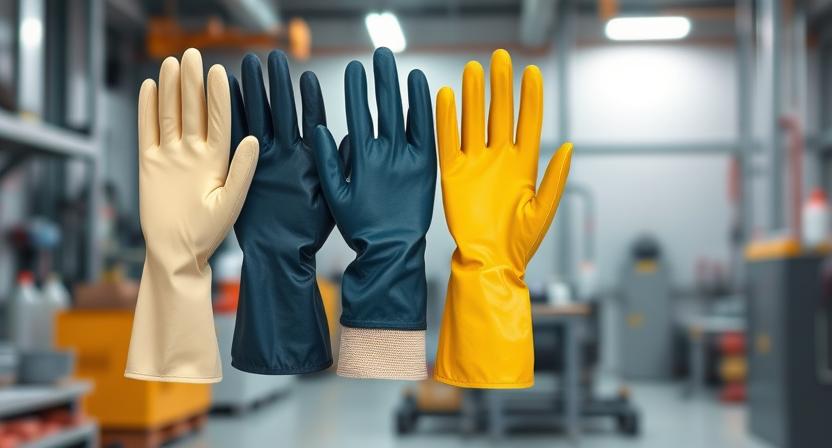Latex vs. Nitrile vs. PVC Dipped Gloves: A Complete Comparison

Introduction
When it comes to industrial hand protection, choosing between latex, nitrile, and PVC dipped gloves can be challenging. Each material offers unique benefits in durability, chemical resistance, comfort, and cost. Whether you’re a manufacturing business owner, safety product supplier, or purchase manager, this guide will help you select the best gloves for your workforce.
1. What Are Dipped Gloves?
Dipped gloves are work gloves with a protective coating (latex, nitrile, or PVC) applied to enhance grip and durability. They are essential in industries like:
✅ Manufacturing – Protects against cuts and abrasions
✅ Chemical handling – Resists acids, oils, and solvents
✅ Automotive work – Provides oil and grease resistance
✅ Food processing – Ensures hygiene and grip
✅ Cleaning & sanitation – Water and chemical protection
2. Latex Dipped Gloves: Pros and Cons
✔ Advantages of Latex Gloves
Superior flexibility – Best for tasks requiring fine motor skills
Excellent grip – Works well in wet and oily conditions
Biodegradable – More eco-friendly than synthetic alternatives
✖ Disadvantages of Latex Gloves
Latex allergies – Can cause skin reactions in some workers
Limited chemical resistance – Not ideal for harsh solvents
Less durable – Tears more easily than nitrile or PVC
Best for: Food handling, medical applications, and general labor.
3. Nitrile Dipped Gloves: Pros and Cons
✔ Advantages of Nitrile Gloves
Chemical & puncture-resistant – Ideal for oils, acids, and solvents
Hypoallergenic – Safe for workers with latex allergies
Long-lasting – More tear-resistant than latex
✖ Disadvantages of Nitrile Gloves
Less flexible – Reduced dexterity compared to latex
Higher cost – More expensive than PVC or latex
Best for: Automotive, chemical industries, and medical fields.
4. PVC Dipped Gloves: Pros and Cons
✔ Advantages of PVC Gloves
Budget-friendly – Most cost-effective option
Water-resistant – Great for wet environments
Decent abrasion resistance – Good for light industrial work
✖ Disadvantages of PVC Gloves
Poor oil resistance – Not suitable for greasy tasks
Stiffer material – Less comfortable for long shifts
Non-biodegradable – Less eco-friendly than latex
Best for: Cleaning, construction, and general maintenance.
6. Which Gloves Are Right for Your Industry?
🏭 Manufacturing & Automotive
➡ Best Choice: Nitrile gloves (oil & chemical resistance)
🧪 Chemical Handling
➡ Best Choice: Nitrile gloves (superior solvent protection)
🍽️ Food Processing
➡ Best Choice: Latex gloves (if no allergies) or nitrile gloves (allergy-safe)
🧹 Cleaning & Sanitation
➡ Best Choice: PVC gloves (budget-friendly & water-resistant)
5. Latex vs. Nitrile vs. PVC Gloves: Key Differences
| Feature | Latex Gloves | Nitrile Gloves | PVC Gloves |
|---|---|---|---|
| Flexibility | ⭐⭐⭐⭐⭐ | ⭐⭐⭐ | ⭐⭐ |
| Durability | ⭐⭐⭐ | ⭐⭐⭐⭐⭐ | ⭐⭐⭐ |
| Chemical Resistance | ⭐⭐ | ⭐⭐⭐⭐⭐ | ⭐⭐⭐ |
| Allergy Risk | High | None | None |
Final Thoughts
Choosing between latex, nitrile, and PVC dipped gloves depends on safety needs, budget, and worker comfort.
Need bulk safety gloves at competitive prices?
📞 Contact us today for expert advice and wholesale options!
FAQs: People Also Ask
Are nitrile gloves better than latex?
Yes, for chemical resistance and durability. However, latex offers better flexibility.
Can PVC gloves handle oils?
No, PVC performs poorly with oils. Nitrile is the best choice for oily tasks.
Why do some industries ban latex gloves?
Due to allergy risks, many workplaces prefer nitrile or vinyl gloves.
Which gloves are most eco-friendly?
Latex is biodegradable, while nitrile and PVC are synthetic.
